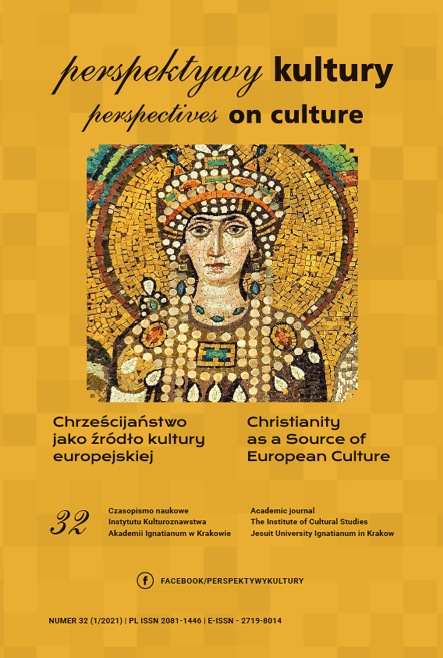The Role of Religious Songs in the Public Speeches of John Paul II during his 1st Pilgrimage to Poland
Abstract
The aim of this article is to examine the functions and circumstances of religious hymns and songs that accompanied the papal speeches during John Paul II’s 1st pilgrimage to Poland. The paper is not about the musical setting of the liturgy, or the songs sung, for example, while waiting for the start of a meeting with the Pope, but about those songs that were performed during his speeches, sometimes interrupting, and sometimes complementing them. The research question is: what role did religious songs play in John Paul II’s public speeches during his first pilgrimage to Poland in June 1979? In order to answer this question I analyzed available video (https://jp2.tvp.pl) and audio materials from that pilgrimage. Three homilies were used as research material: the homily delivered in Warsaw at Plac Zwycięstwa on 2 June 1979 and the homily given in Częstochowa on 6 June 1979, during the Mass for pilgrims from Upper Silesia and the Dąbrowa Basin, in addition to the homily delivered in Auschwitz-Birkenau on 7 June 1979. This is followed by the speech delivered at Lech Hill in Gniezno on 3 June 1979, the speech addressed to young people gathered at the Krakow Skałka on 8 June 1979, and, finally, conversations with young people gathered under the window at Franciszkańska 3 in Krakow.
References
Cygański, A. (2018). Dialogiczny wymiar homilii po Soborze Watykańskim II. Kraków: Wydawnictwo Unum.
Jan Paweł II (2010). Pielgrzymki do ojczyzny. Przemówienia, homilie. Kraków: Znak.
Jankosz, M. (2018). Sytuacje komunikacyjne publicznych wystąpień Jana Pawła II podczas I pielgrzymki do Polski. Polonia Sacra, 50, 183–194.
Jankosz, M. & Przyczyna, W. (2020). Forma, język i styl homilii ojca Adama Szustaka, księdza Piotra Pawlukiewicza i arcybiskupa Grzegorza Rysia. Stylistyka, XXIX, 131–145.
Przyczyna, W. (2013). Homilia pięćdziesiąt lat po Soborze Watykańskim II. Pytania, problemy, wyzwania. Kraków: Wydawnictwo M.
Przyczyna, W. (2020). Pojęcie homilii i kazania. Ujęcie homiletycznoteologiczne. In W. Przyczyna & K. Skowronek (eds.), Język homilii i kazań. Tarnów: Wydawnictwo Biblos.
Przyczyna, W. & Skowronek, K. (2020). Wstęp. In W. Przyczyna i K. Skowronek (eds), Język homilii i kazań. Tarnów: Wydawnictwo Biblos.
Sieradzka-Mruk, A. (2009). Język kaznodziejski jako przykład polszczyzny mówionej (wybrane aspekty). In B. Dunaj & M. Rak (eds.), Polszczyzna mówiona ogólna i regionalna. Materiały ogólnopolskiej konferencji naukowej, Kraków 25–26 września 2008. Kraków, 357–364.
Wilkoń, A. (2000). Typologia odmian językowych współczesnej polszczyzny. Katowice: Wydawnictwo Uniwersytetu Śląskiego.
Woźniak, Z. (2015). Kilka uwag o języku współczesnych pieśni i piosenek religijnych. Colloquia Theologica Ottoniana, 1, 171–190.
Zdunkiewicz-Jedynak, D. (1996). Językowe środki perswazji w kazaniu. Kraków: Poligrafia Salezjańska.
Zerfass, R. (1995). Od aforyzmu do kazania. Kraków: Poligrafia Salezjańska.
Copyright (c) 2021 Jesuit University Ignatianum in Krakow

This work is licensed under a Creative Commons Attribution-NoDerivatives 4.0 International License.
Autor, zgłaszając swój artykuł, wyraża zgodę na korzystanie przez Wydawnictwo Uniwersystet Ignatianum z utworu na następujących polach eksploatacji:
- utrwalania utworu w formie papierowej, a także na nośniku cyfrowym lub magnetycznym;
- zwielokrotnienia utworu dowolną techniką, bez ograniczenia ilości wydań i liczby egzemplarzy;
- rozpowszechniania utworu i jego zwielokrotnionych egzemplarzy na jakimkolwiek nośniku, w tym wprowadzenia do obrotu, sprzedaży, użyczenia, najmu;
- wprowadzenia utworu do pamięci komputera;
- rozpowszechniania utworu w sieciach informatycznych, w tym w sieci Internet;
- publicznego wykonania, wystawienia, wyświetlenia, odtworzenia oraz nadawania i reemitowania, a także publicznego udostępniania utworu w taki sposób, aby każdy mógł mieć do niego dostęp w miejscu i czasie przez siebie wybranym.
Wydawca zobowiązuje się szanować osobiste prawa autorskie do utworu.





